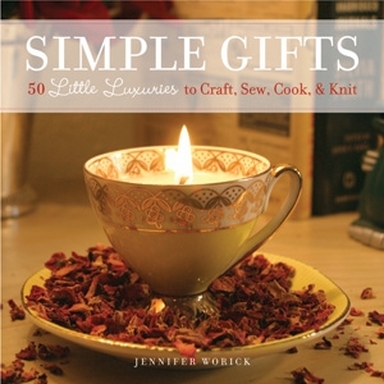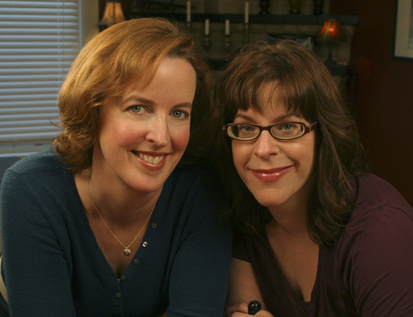To enter the giveaway to win a copy of Simple Gifts: 50 Little Luxuries to Craft, Sew, Cook, & Knit leave a comment here by Tuesday, May 31 at noon EST.
Q: First, tell me about the workshops you've been teaching!
Worick: My pal, Kerry Colburn, and I have been asked many, many times for publishing advice. She’s an author who was an executive editor at Chronicle Books and I’m an author who was editorial director at Running Press. So we’ve been on both sides of reviewing and writing book proposals and it seemed like a natural next step to share our insight to groups of aspiring authors. So we give talks and workshops to help folks write salable proposals and learn about the publishing industry. We currently offer events in Seattle but are looking at creating e-courses and electronic multi-media kits, as well as hosting events in different cities, in the next few months.
Worick: Craft books, in some respects, are like cookbooks. Any sort of how-to book proposal needs to take into account that the projects will need tech editing and review for clarity and viability of projects. I think it’s helpful to include a complete list of the projects you’d plan to include, as well as step-out snapshots of a couple of projects (photos that match each step in the project).
There are a lot of craft books on the market so it’s also important to think about how your group of projects thematically hang together and are different from what’s already on the market. Are they all projects made for pets? Do they all have a floral motif? Are they all variations on a technique?
Q: How does an author make their proposal stand out from the field (either craft book proposal, or other non-fiction), and then how do you make your marketing efforts (to sell the published book) stand out from the field--especially in the craft world, which is starting to feel sort of saturated?
Worick: What Kerry and I advise in our Business of Books talks is that you first start in researching, not just your idea, but the market as well. It’s important to refine your idea based on what you see in the marketplace (both in the bookstore and online). If someone can get hundreds of free shawl patterns online to knit, what is going to make her shell out money for yours? What makes them so special? Do they all have intarsia designs that you’ve spent a long time figuring out? If there is something out there similar to yours, don’t despair. Just spend some time thinking about how to make yours more original and distinctive.
When it comes to marketing, there is a active online community for crafters so I’d recommend contributing to websites, commenting on other blogs, and writing your own blog. You’ll build up a community that can help evangelize your book when it comes out.
Q: What is the most challenging thing about doing a craft book proposal today (versus a few years ago)?
Worick: As you said, there is a lot of saturation in the market and it’s a tricky thing to find a great, specific idea that’s not TOO niche. Crafters are eager for the next thing to expand their skill set and blow their mind creatively, so if you can keep that in mind when developing your idea, you’ll strengthen its chances of being published. I wrote Backcountry Betty: Crafting in Style because I saw a desire to repurpose materials, incorporate natural elements you may have collected in a new way, and create inexpensive but clever projects.
Q: What is the most exciting thing about doing a craft book proposal today?
Worick: Well, for me, it’s two things: refining the overall concept and then brainstorming the individual projects. I don’t usually have all the projects figured out when I first develop a proposal. The creativity starts flowing and my ideas get more and more brilliant as I push myself to come up with fresh projects.
Q: Do you have like a top 3 list of the absolute best tips for pulling together your proposal (any proposal--craft or otherwise)?
Worick: Well, we have eight elements of a proposal that we talk about in our talks. But as far as tips:
1. Do your homework. Research and refine your idea.
2. You don’t have to write the book to sell the book.
3. Have a trusted friend review your proposal, maybe even a non-crafter. It’s important that you don’t assume anything and that your directions make sense. And sometimes as the author, you can’t see what’s missing or unclear.
Q: How important is negotiating with the publisher? This is foreign territory for many craft book authors, who are used to dealing with customers or running a business, but not necessarily negotiating rights and things for a manuscript.
Worick: It’s often hard to advocate for ourselves when we are negotiating a book deal. But that said, there are all sorts of points that have some wiggle room. If they won’t budge on royalty, then ask for a bigger advance or a “production grant” (a fee that you can use for materials or project development that won’t be part of your royalty). You can also ask for an escalator, where your royalty will increase when you hit a certain number of sales (say 15,000 units). And know all your options, what your bottom line is, and explore self-publishing options so you can see what might make sense for you. If you want all the control, have a large online community, and want to get your book to market quickly, self-publishing an e-book might be the way to go.
Q: Finally, can you talk about why it's important to build relationships with people--agents, publishers, press people, other authors/bloggers, etc--in order to really be successful in the bookselling business?
Worick: I think anything you can do to increase your knowledge of the publishing industry will help you in your quest to get published. Reading Shelf Awareness or subscribing to Publishers Marketplace can also help give you an idea of what deals are being made, what issues are of greatest concern to the industry, that sort of thing. You will become savvier and have a better idea of how to position yourself as the author and market your book effectively. Talk to your local bookstore staff, develop relationships with your crafting community and shops (again, both online and brick-and-mortar stores). As you build relationships and credibility, you increase your ability to market your book. You are probably already doing this naturally, because it’s where your interest lies. Just bring some mindfulness and purpose to your efforts and you’ll quickly become a desirable and marketable author.




 RSS Feed
RSS Feed